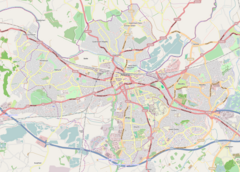
Reading is a town and borough in Berkshire, England. Most of its built-up area lies within the Borough of Reading, although some outer suburbs are parts of neighbouring local authority areas. Located in the Thames Valley at the confluence of the rivers Thames and Kennet, Reading is 40 miles (64 km) east of Swindon, 25 miles (40 km) south of Oxford, 40 miles (64 km) west of London and 16 miles (26 km) north of Basingstoke.

Woburn Abbey, occupying the east of the village of Woburn, Bedfordshire, England, is a country house, the family seat of the Duke of Bedford. Although it is still a family home to the current duke, it is open on specified days to visitors, along with the diverse estate surrounding it, including the historic landscape gardens and deer park, as well as more recently added attractions including Woburn Safari Park, a miniature railway and a garden/visitor centre. It was built by William Russell, 1st Baron Russell of Thornhaugh.

Lancelot Brown, more commonly known as Capability Brown, was an English gardener and landscape architect, who remains the most famous figure in the history of the English landscape garden style. He is remembered as "the last of the great English 18th-century artists to be accorded his due" and "England's greatest gardener".

Caversham is a village and suburb of Reading in Berkshire, England, located directly north of Reading town centre across the River Thames. Caversham rises from the River Thames, lying on flood plain and the lowest reaches of the Chiltern Hills. Two road bridges, including Caversham Bridge, and two footbridges join Caversham to the rest of Reading. Named areas within the village include Emmer Green, Lower Caversham, Caversham Heights and Caversham Park Village. Notable landmarks include Caversham Court, a public park and former country house; Caversham Lakes; and part of the Thames Path national trail.

Earl Cadogan is a title that has been created twice in the Peerage of Great Britain for the Cadogan family. The second creation, in 1800, was for Charles Cadogan, 3rd Baron Cadogan.

The Leasowes is a 57-hectare estate in Halesowen, historically in the county of Shropshire, later Worcestershire, England, comprising house and gardens. The parkland is now listed Grade I on English Heritage's Register of Parks and Gardens and the home of the Halesowen Golf Club. The name means "rough pasture land".

Lieutenant-General William Cadogan, 1st Earl Cadogan was an Irish-born British Army officer. He began his active military service during the Williamite War in Ireland in 1689 and ended it with the suppression of the 1715 Jacobite Rebellion. A close associate and confidant of the Duke of Marlborough, he was also a diplomat and Whig politician who sat in the English and British Houses of Commons from 1705 until 1716, when he was raised to the peerage as Baron Cadogan.

Aldermaston is a village and civil parish in Berkshire, England. In the 2011 census, the parish had a population of 1,015. The village is in the Kennet Valley and bounds Hampshire to the south. It is approximately 8 miles (13 km) from Newbury, Basingstoke, and Reading and is 46 miles (74 km) from London.
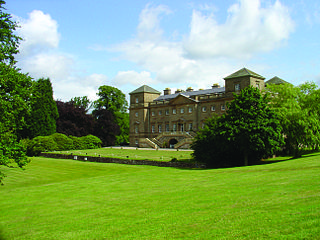
Hagley Hall is a Grade I listed 18th-century house in Hagley, Worcestershire, the home of the Lyttelton family. It was the creation of George, 1st Lord Lyttelton (1709–1773), secretary to Frederick, Prince of Wales, poet and man of letters and briefly Chancellor of the Exchequer. Before the death of his father in 1751, he began to landscape the grounds in the new Picturesque style, and between 1754 and 1760 it was he who was responsible for the building of the Neo-Palladian house that survives to this day.
Thomas Whately, an English politician and writer, was a Member of Parliament (1761–1768) who served as Commissioner on the Board of Trade, as Secretary to the Treasury under Lord Grenville, and as Under-secretary of State under Lord North (1771–1772). As an MP he published a letter on the reasonableness of the Stamp Act, 1765, which earned him a place in the events that led to the American Revolution.
Henry Cadogan of Liscartan, County Meath was an Irish barrister.
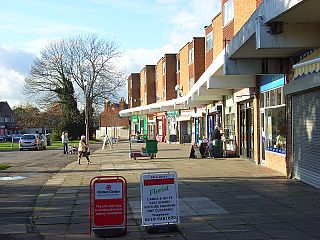
Emmer Green is the northernmost suburb of Reading in Berkshire, England, centred around 2 miles (3.2 km) north of the town centre. Having most of its own commerce, sport and other amenities, Emmer Green has an arbitrary divide with larger Caversham and a border with Oxfordshire, the county in which both places formerly stood.

Painshill, near Cobham, Surrey, England, is one of the finest remaining examples of an 18th-century English landscape park. It was designed and created between 1738 and 1773 by Charles Hamilton. The original house built in the park by Hamilton has since been demolished.

Caversham Court is a public garden and was a mansion located on the north bank of the River Thames in Caversham, a suburb of Reading in the English county of Berkshire. The park lies within the St Peter's conservation area. The park is listed as Grade II in the National Register of Historic Parks and Gardens.
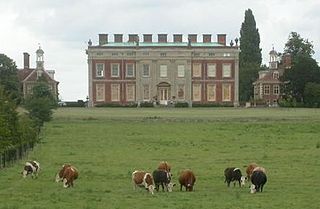
Wotton House, Wotton Underwood, Buckinghamshire, England, is a stately home built between 1704 and 1714, to a design very similar to that of the contemporary version of Buckingham House. The house is an example of English Baroque and a Grade I listed building. The architect is uncertain although William Winde, the designer of Buckingham House, has been suggested. The grounds were laid out by George London and Henry Wise with a formal parterre and a double elm avenue leading down to a lake. Fifty years later William Pitt the Elder and Capability Brown improved the landscape, creating pleasure grounds with two lakes. After a fire gutted the main house in 1820 Richard Grenville, 1st Earl Temple, commissioned John Soane to rebuild it. After the 3rd Duke of Buckingham and Chandos, the last direct Grenville male heir, died in 1889, the house was let to a succession of tenants; including, notably; the philanthropist, Leo Bernard William Bonn (1850-1929) who became deaf while residing at Wotton, and later founded (1911) what became the RNID. His son and heir, the decorated First World War hero, Major Walter Basil Louis Bonn, DSO, MC, MA (Oxon.) FRSA, FZSL (1885-1973) is also listed as resident at Wotton House; in the New College archives, at Oxford University; during his three years as an Oxford undergraduate, there, 1903–1906, while living fifteen miles away from his family home of many years, at Wotton House.
General Charles Cadogan, 2nd Baron Cadogan was an Anglo-Irish peer, soldier and Whig politician.
Charles Marsack was an East India Company army officer and landowner who, from seemingly humble origins had made a fortune in India, and according to stories first published in Burke's Landed Gentry in 1894, was reputedly the son of Frederick, Prince of Wales or of King George II by a so-called Comtesse de Marsac. He was said to have been born about 1735-6 but was probably born in 1747-8 and was said to have married in 1767. He was actually the son of Jean Charles Marsac (1708-1751), a servant to one of George II's pages, Joachim Lorentz Sollifoffer, who in his will made generous provision for the widowed Margaret Marsac née Saunders and her child Jean Charles who was his godson. Jean Charles Marsac's father was the son of a migrant from Poitou, also called Charles Marsac, a carpenter, who had come to England before 1704/5. Jean Charles Marsac was usually called Charles Marsac and was apprenticed as a weaver. He died in Kensington in 1751, having married at St Martin in the Fields in 1745/6 one Margaret Saunders who was probably related to Thomas Saunders, standing wardrobe keeper to George I and George II. She married secondly at St George's Chapel, Mayfair, John Holcroft, and died in 1785, her administration being granted to Charles Marsack her 'natural and lawful son'. By her second husband she had a daughter Margaretta Holcroft (1755-1785) who lived with William Roome and had several illegitimate children by him who spread the story that she was the daughter of Margaret, Comtesse de Marsac.
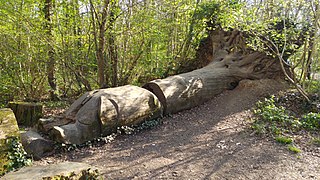
Clayfield Copse is a local nature reserve on the northern edge of the suburb of Caversham in Reading, UK. The site is 8.65 hectares in size and is a natural open space consisting of fields, wild flower meadow and native woodlands adjoining the Oxfordshire countryside. Some of the woodland is being actively managed as hazel coppice, and traditional dead hedging defines some of the ancient woodland areas. The site is the only outcrop of London Clay north of the River Thames in Reading and makes up the southern tip of the Chiltern Hills. The nature reserve is under the management of the Reading Borough Council.

The following is a timeline of the history of Reading, the county town of Berkshire in England.

